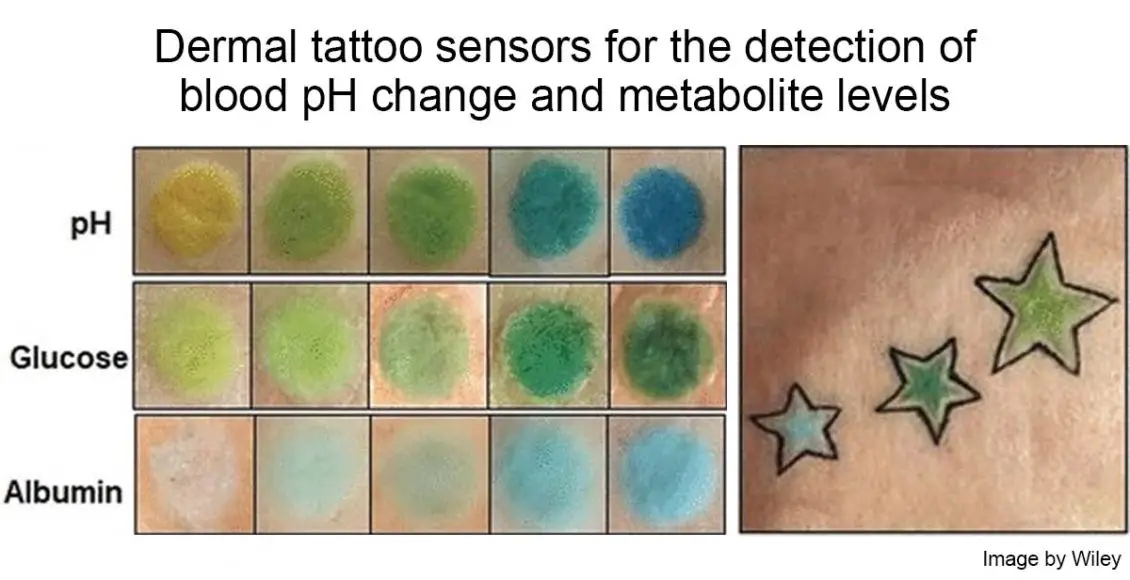Sensing with your skin – new dermal tattoo sensor technology to detect changes in blood pH and metabolite levels

A team of scientists in Germany have created an intradermal tattoo that changes color in response to changing levels of pH, glucose, or albumin.
The tattoo has still not been tested on humans, but pieces of pigskin were transformed into a range of different hues as researchers tweaked the biomarkers’ key concentrations.
This is a strong finding that could lead to tattoos that would give doctors and patients the opportunity to monitor chronic diseases in real-time; eg. kidney disease or diabetes.
Led by Ali Yetisen, chemical engineer of the Technical University of Munich, the team was able to estimate the concentrations based on smartphone photos of the tattoos with great accuracy.

Credit: Wiley
This could prove to be an incredible technology for personalized medicine even though not all the dyes are reversible yet.
“Body modification by injecting pigments into the dermis layer is a custom more than 4000 years old,” the scientists wrote in their research paper.
“Here, a functional cosmetic technology was developed by combining tattoo artistry and colorimetric biosensors… Dermal tattoo sensors functioned as diagnostic displays by exhibiting colour changes within the visible spectrum in response to variations in pH, glucose, and albumin concentrations.”
The biomarkers often serve as indicators that something is not right. Albumin is a blood plasma protein, and when it has low levels it may indicate liver or kidney issues, while high levels may indicate heart issues.
Diabetes impairs the ability of the body to metabolize sugars, hence glucose needs to be monitored closely for its management.
pH level blood changes – alkalosis for high pH, acidosis for low levels- can be caused by a variety of issues which should be examined by professionals.
The scientists created a different color-shifting dye that could accurately detect changes in each of the biomarkers situated in the interstitial fluid (the liquid that leaks out of your capillaries, filling the spaces between cells while transporting things like glucose and oxygen.)
The albumin sensor is based on a yellow dye that, when associating with the albumin protein shifted to green.
The glucose sensor took advantage of the enzymatic reactions of peroxidase and glucose oxidase; the changing glucose concentration creates a structural change in the pigment turning yellow to dark green.
The sensor of the pH consisted of phenolphthalein, methyl red, and bromothymol blue dyes.
At a range of 5 to 9, human blood pH goes around 7.4, and the sensor ranges from yellow to blue.
As soon as the biomarker levels were changed in the pigskin interstitial fluid (a common tattoo medium which tattooists practice on), the colors shifted too.
Only the pH sensor color was reversible – and the tattoo isn’t of much help if it only works for a single reading.
The researchers stated that the other colors could possibly be made reversible with synthetic receptors. However, they have yet to be tested in future research.
In order to see if the inks can cause adverse reactions, the next step for the researchers would be to test the tattoos on living animals.
As MIT scientists said when in 2017 they developed similar color-changing tattoo inks, this process could take time, but it would definitely be worth it in the end.
“The applications of the sensors can be extended to the detection of electrolytes, proteins, pathogenic microorganisms, gases, and dehydration status,” they wrote.
“The developed dermal sensors may have an application in medical diagnostics to monitor a broad range of metabolite biomarkers.”
How do you feel about this groundbreaking discovery? Share your thoughts with us in the comment section below.


